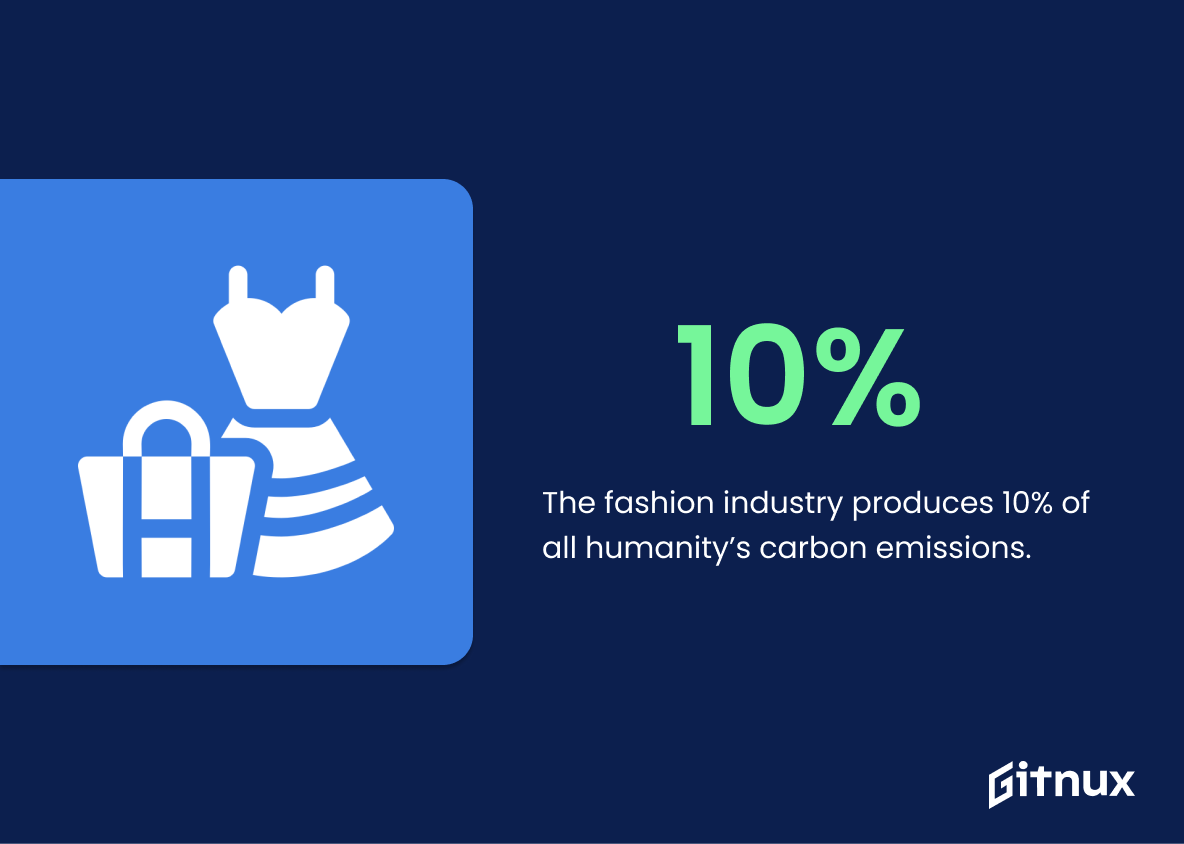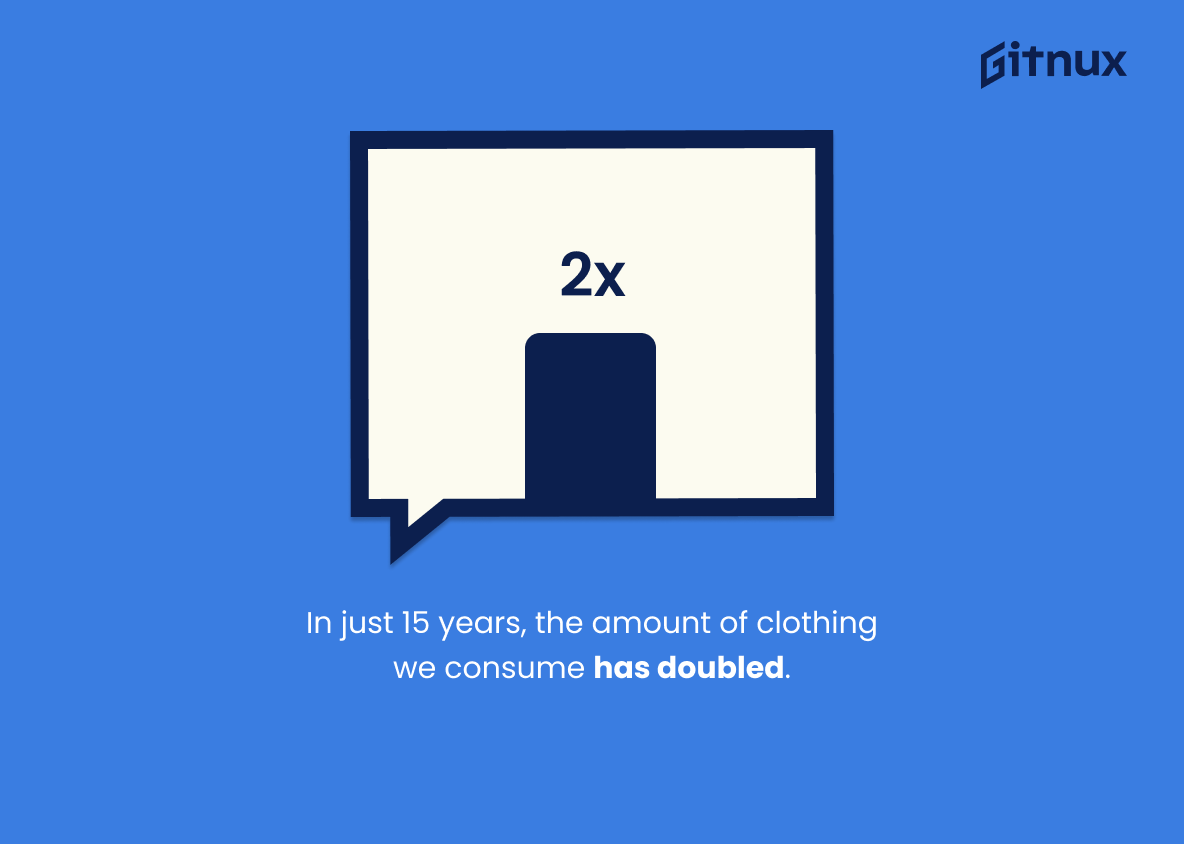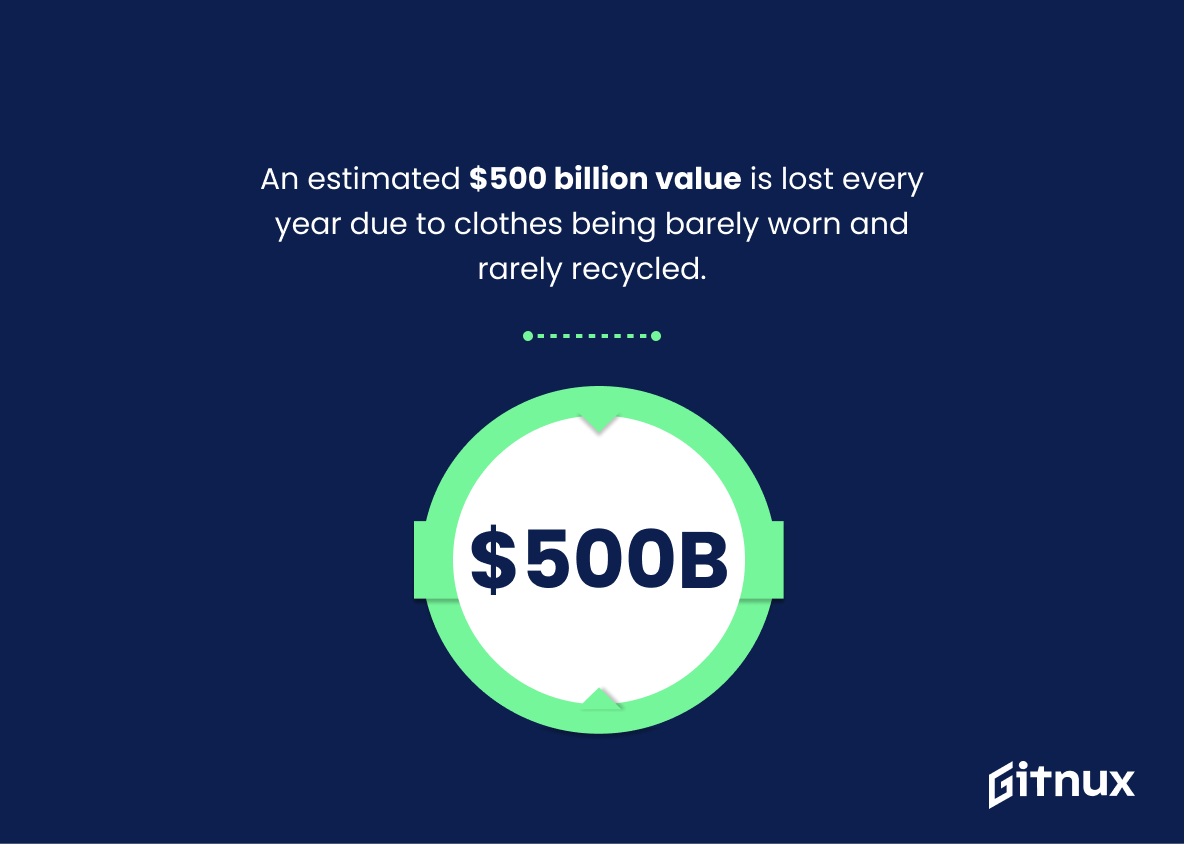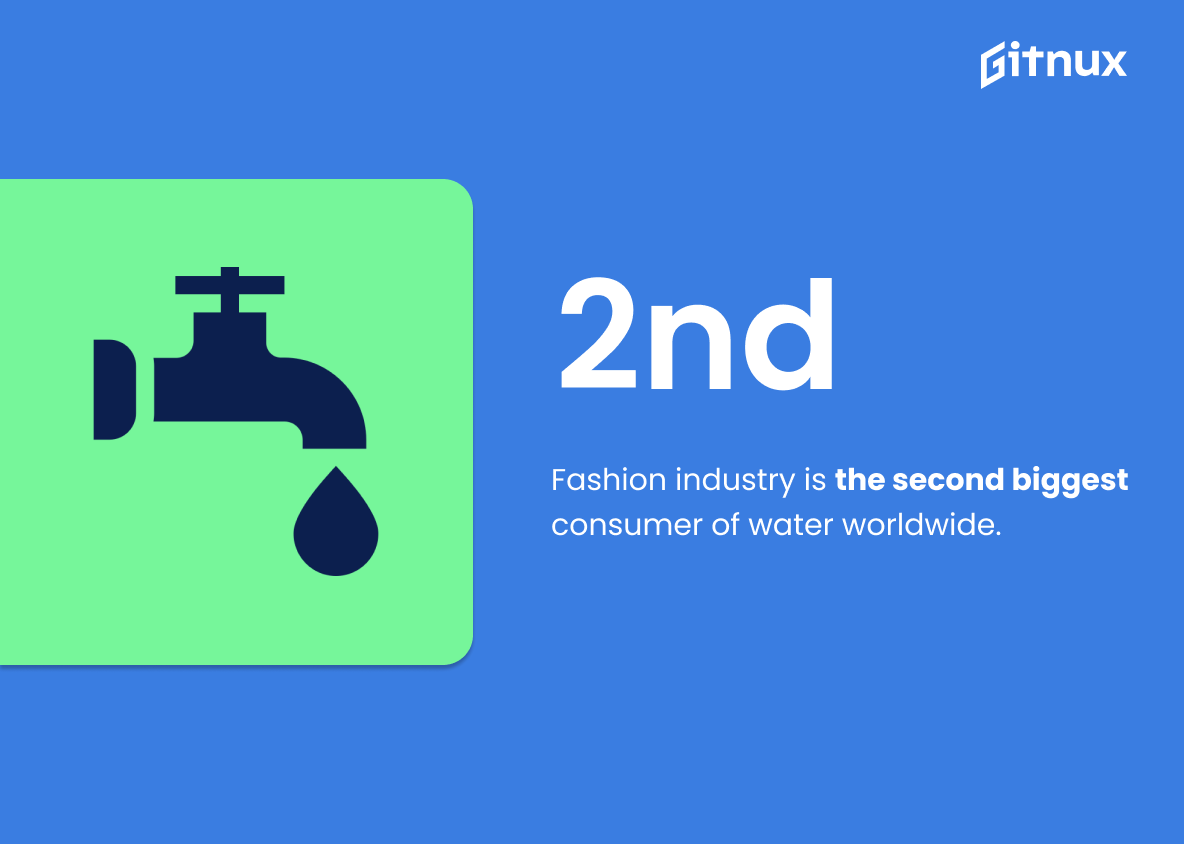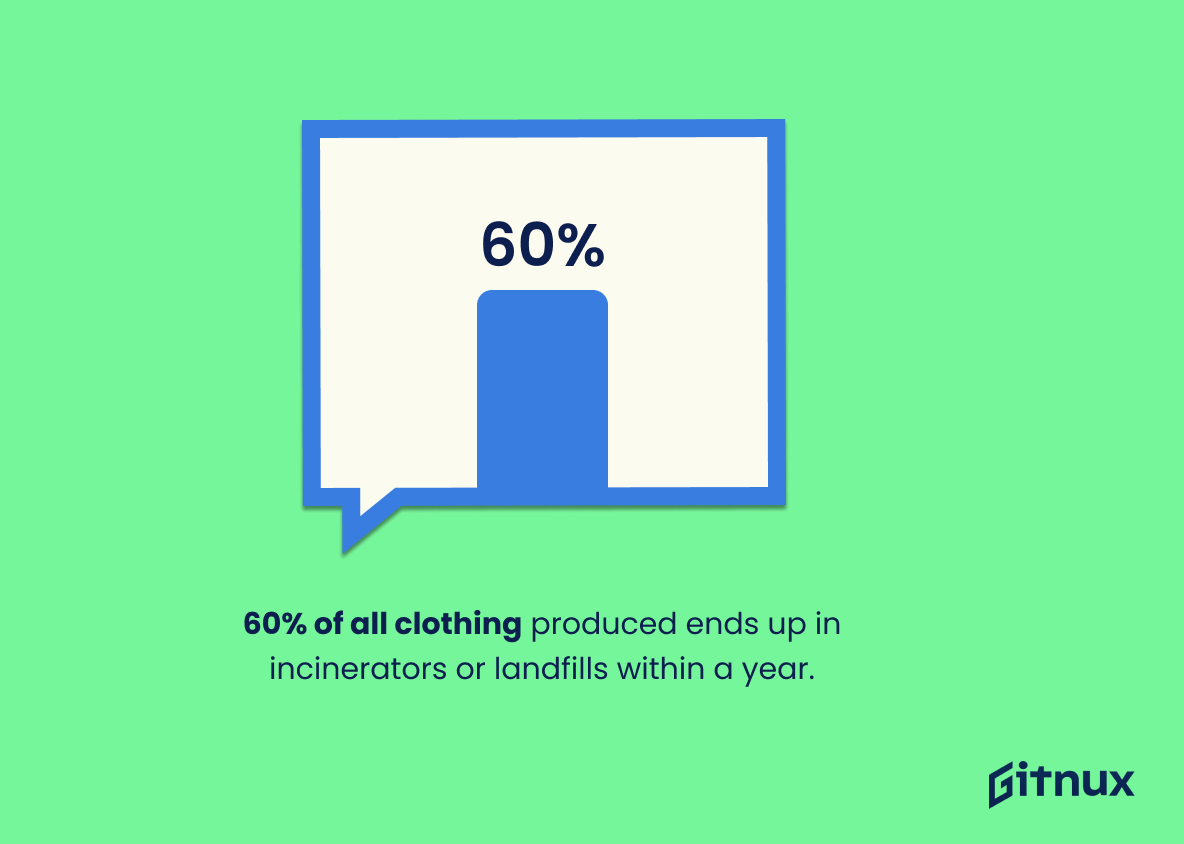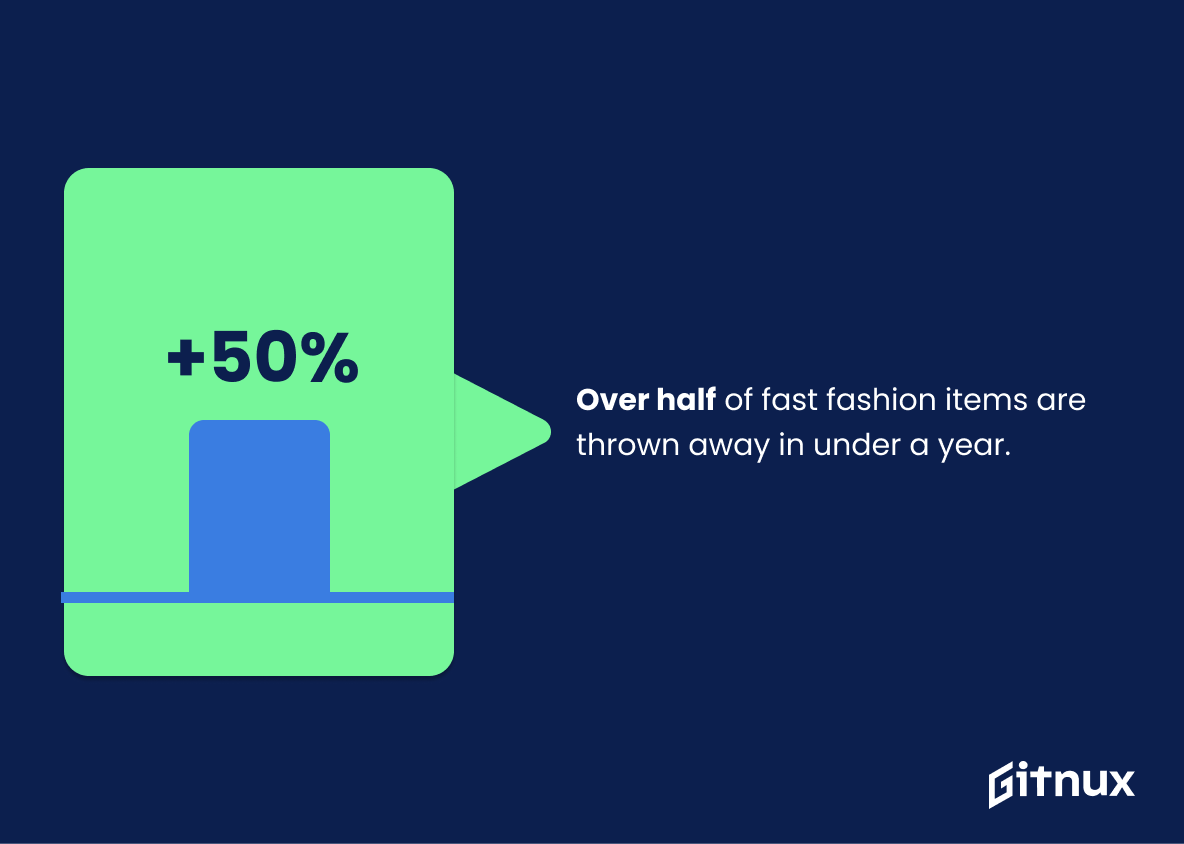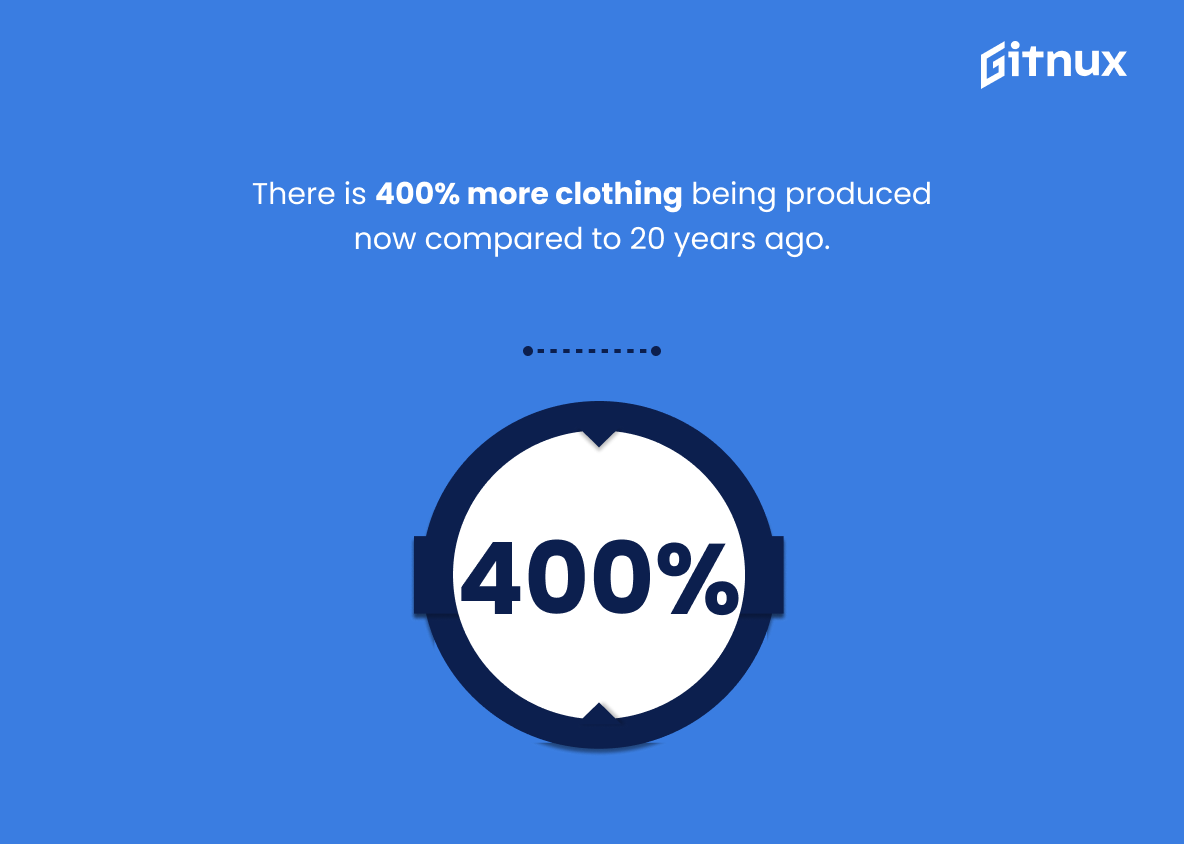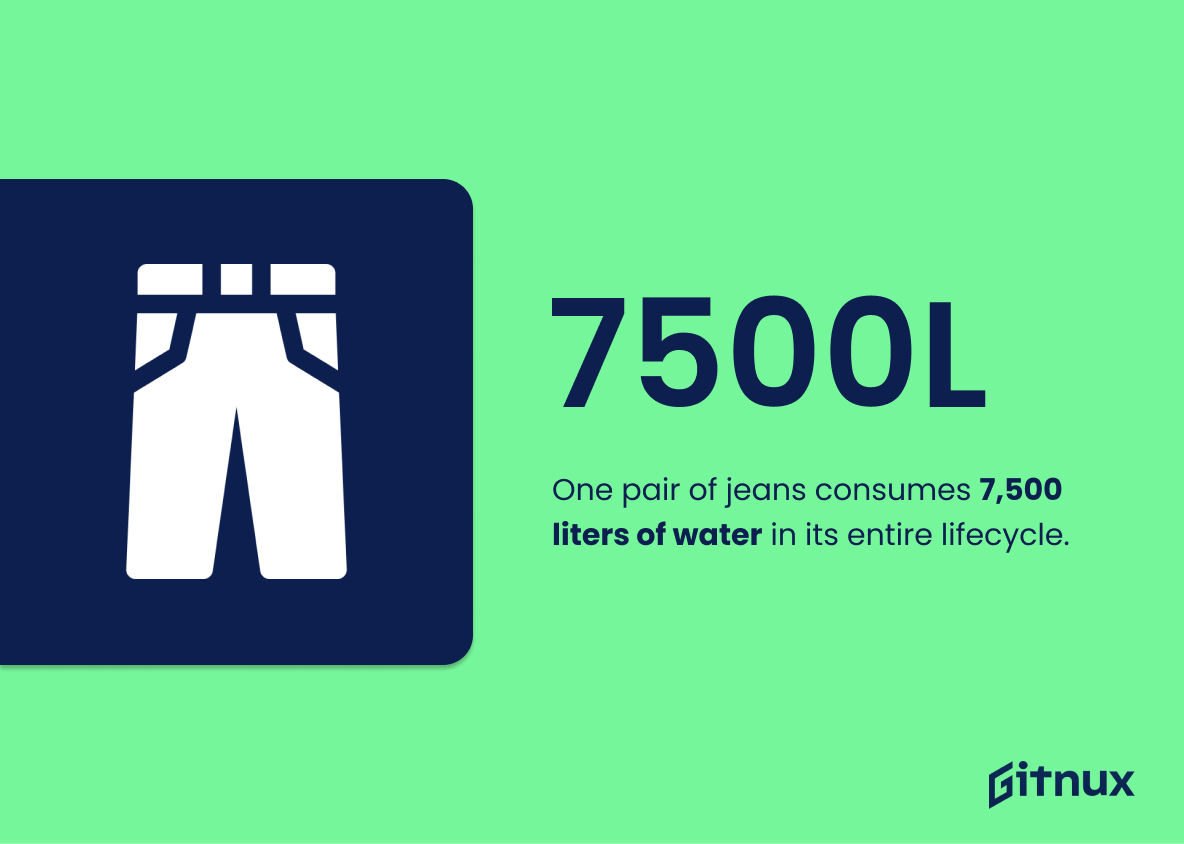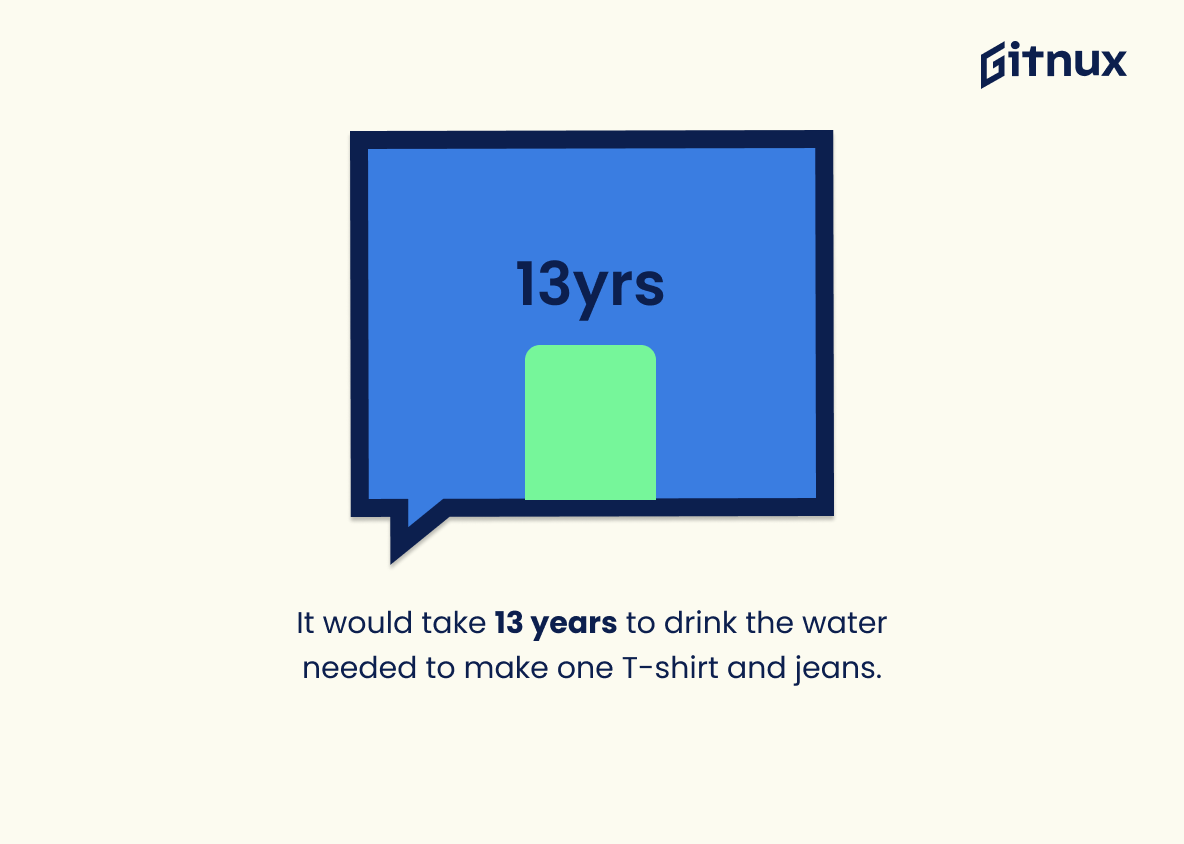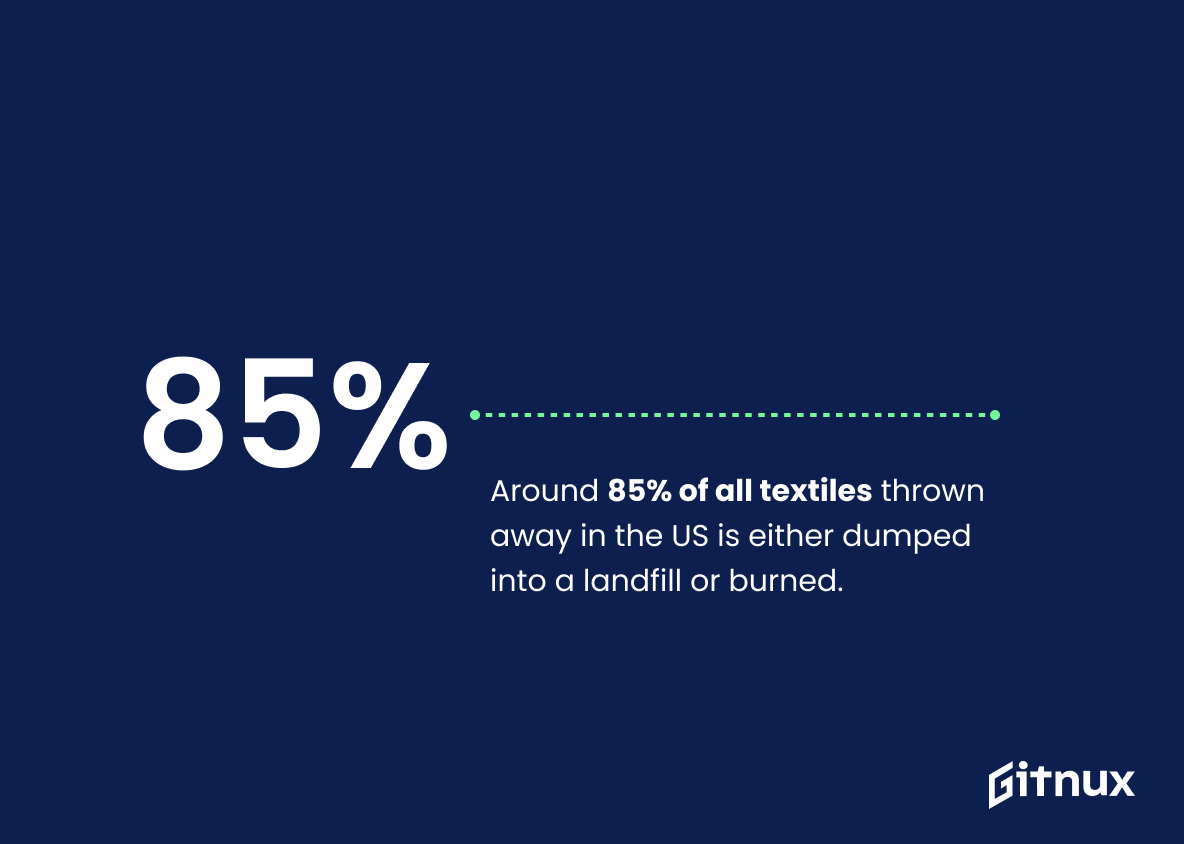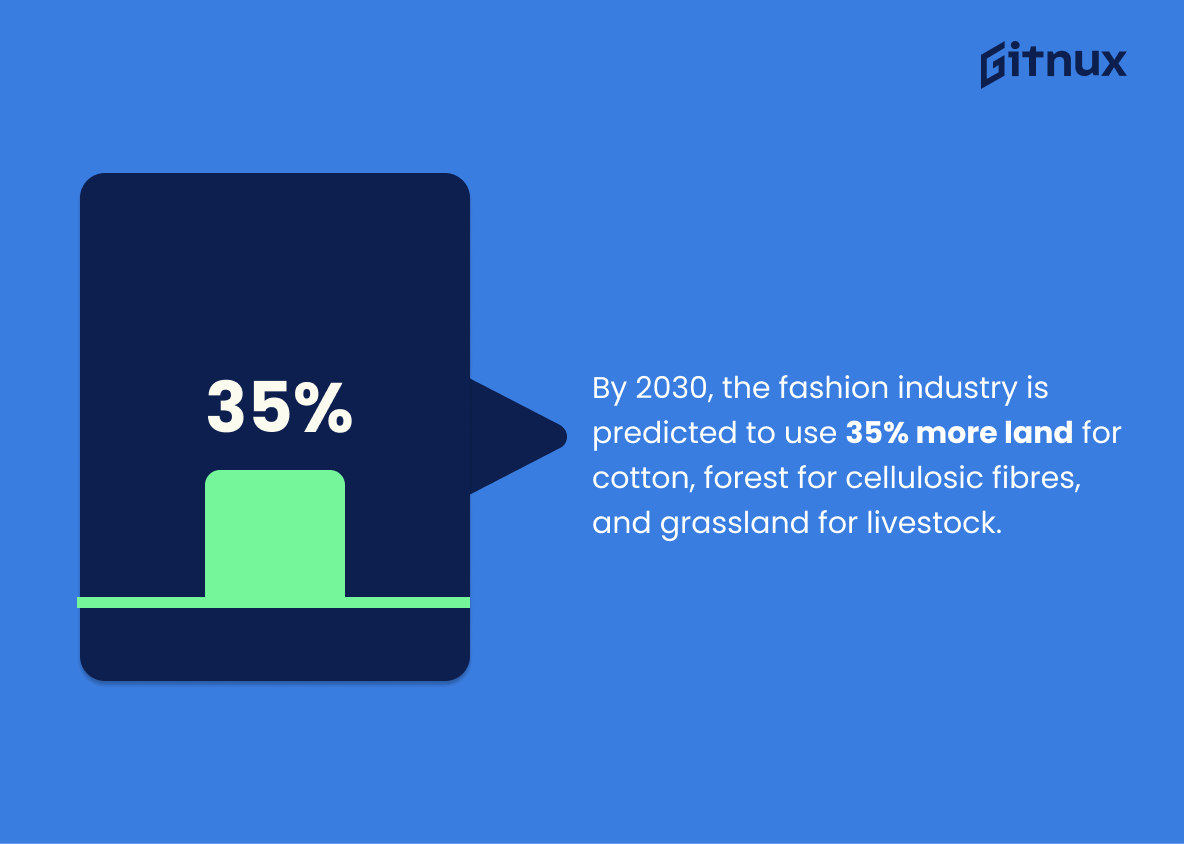In today’s rapidly evolving fashion landscape, the culture of ‘out with the old, in with the new’ has given birth to an era of fast fashion. But behind the allure of trendy, modestly priced clothes lie startling statistics that reveal an inconvenient truth about fast fashion waste.
With clothing trends changing faster than the seasons, mountains of unwanted clothes are piling up in landfills, leading to serious environmental concerns. Join us as we delve deeper into the shocking waste statistics of the fast fashion industry, which underline the urgency to shift our consumption patterns towards a more sustainable future.
The Latest Fast Fashion Waste Statistics Unveiled
The fashion industry produces 10% of all humanity’s carbon emissions.
Diving deep into the tide of numbers, the statistic that unravels the fashion industry being responsible for 10% of all humanity’s carbon emissions illuminates a stark reality. Interwoven deep within the fabric of our blog post about Fast Fashion Waste Statistics, this number casts its shadow over our fast fashion consumption habits.
When you slip into that stylish, eye-catching outfit, produced with blistering speed to keep up with ever-evolving trends, you’re inadvertently part of this figure. Unknowingly, you’re contributing to turning our planet into a runway of greenhouse gases, one that’s getting warmer with each step.
This ominous 10% leads the narrative away from just frivolous fashion and into the domain of environmental conservation. Drawing this connection, it amplifies the urgency of re-thinking and re-modeling our fashion choices to be more conscious, ethical and sustainable, sewing the concept of ‘slow fashion’ into everyone’s psyche. To truly appreciate the magnitude of fast fashion waste, one must grapple with these harrowing numbers, and understand what they signify for the collective health of our planet.
In just 15 years, the amount of clothing we consume has doubled.
This staggering statistic punctuates a fundamental truth about the thriving phenomena of fast fashion: it’s not a sustainable practice. As our collective appetite for clothing has surged in a mere decade-and-a-half, doubling our consumption, it underscores the acceleration of a throwaway clothing culture that our planet can ill afford.
The rate of manufacturing, purchasing, and subsequently discarding, paints an alarming picture of environmental impact. As a harbinger of mounting textile waste, this statistic stands testament to the urgent need for reform in our fashion consumption habits, challenging us to look beyond the enticing price tags and fleeting trends to unravel the true cost of fast fashion.
Every second, one garbage truck of textiles is landfilled or burned.
Painting a vivid canvas, this staggering fact presents the urgency of the situation in the realm of fast fashion. With every ticking second, a garbage truck’s worth of textiles finds its fate either buried in the landfill or disappearing in smoke. Such a glaring quantity mirrors the unsustainability rampant in fast fashion industry, underlining the relentless production and disposal pattern, fueled by consumers’ insatiable demand for trendy, disposable apparel.
This gives our blog post an alarming backdrop, shedding an unflattering, yet necessary, spotlight on the extent of textile waste generated by the fast fashion industry. It hands over the power of knowledge and perspective to our readers, impelling them to ponder over their societal and consumer choices. Indeed, this statistic is no ordinary number; instead, it serves as a strident alarm, urging us all to contribute towards sustainable fashion practices.
Only 1% of clothing is recycled into new garments.
In the ever-evolving world of fashion, we often get swept up in the allure of the ‘new’, flocking from one trend to the next. Yet, unearthing the facts tell a stark story: a paltry 1% of our clothing is recycled into fresh threads. The embroidery of this statistic into a fast fashion narrative is a significant wake-up call, highlighting the monumental waste generated within the industry’s cycle.
It sews a vivid picture of just how much material is left cast aside, forgotten on the cutting room floor, and gives a real measure to the swift, increasingly short lifespan of fashion items. It’s an arresting reality-check, pointing a spotlight on the urgent need for sustainable practices. Indeed, this mere 1% captures the degree of the challenge, shedding light on the vast, underexplored potential for recycling in bringing about a turning point in our fashion waste crisis.
An estimated $500 billion value is lost every year due to clothes being barely worn and rarely recycled.
Reflecting on the rapid pace of the fashion industry, the staggering figure of $500 billion lost annually through barely worn and seldom recycled clothing unveils a significant problem. In the canvas of fast fashion waste statistics, this datum paints a grim portrait of extravagance, waste, and missed opportunities for recycling and sustainability. It’s a silent scream for more mindful consumption and improved recycling practices.
This ominous economic toll embodies not only the fiscal cost; it also signifies a mounting environmental debt we are accruing — a debt that future generations are obligated to repay. Each unworn outfit or unrecycled fabric is a thread in the ever-increasing tapestry of fast fashion waste, making this statistic a call to action for every involved stakeholder, from manufacturers to consumers.
Fashion industry is the second biggest consumer of water worldwide.
Illuminating the enormity of fashion industry’s ecological footprint, the startling statistic that it ranks second in global water consumption makes a powerful statement. Framed in the context of Fast Fashion Waste Statistics, it unveils a sobering truth: the glitz and glamour of runway realities carry the weight of massive water consumption. As fast fashion manufactures garments swiftly and cheaply, it intensifies the demand on water resources, from growing raw materials to dyeing and finishing processes.
This data point therefore underscores the urgent need for sustainable fashion practices, throwing light on the hidden and often overlooked environmental impact of our insatiable appetite for the latest clothing trends.
60% of all clothing produced ends up in incinerators or landfills within a year.
Highlighting the statistic that 60% of all clothing ends up in incinerators or landfills within a year, paints a stark picture of the excessive waste generated in the fast fashion industry. Every stitch we wear seems to transition from the store to our wardrobes, to ultimately becoming disturbingly silent contributors to mounting waste piles.
In the context of our blog post on Fast Fashion Waste Statistics, this shrewd statistic not only pulls the curtain back on the industry’s reckless disregard for sustainability, but also pinpoints the urgent need for change. It serves as a grim reminder for consumers and industry influencers alike, that for the sake of our environment, embracing sustainable fashion practices is not just a trend, but a necessity.
Over 90% of workers in the global garment industry cannot negotiate their working conditions.
Woven into the fabric of our discussion on Fast Fashion Waste Statistics is a profound insight revealing a stark reality – over 90% of those laboring tirelessly in the global garment industry are ensnared in a predicament devoid of any bargaining power over their working conditions. Their plight mirrors the incessant cycle of the fast fashion industry we are scrutinizing, another dimension of waste not readily apparent but equally concerning. Gradually, what was once an abstract percentage takes a human shape through the narrative of countless workers.
It illustrates an integral part of the fast fashion chain, unmasking the true cost of the trend-driven, throwaway clothing market – the exploitation of workers. As we delve deeper into the environmental concerns fast fashion poses, it is impossible to overlook this grim statistic, for its significance extends beyond sheer numbers, reminding us that the issue at hand relates not only to wastage of resources but also wastage of dignity and fair treatment for the global garment force.
Over half of fast fashion items are thrown away in under a year.
Depicting the sheer mass of fast fashion garments that end up discarded in less than a year’s time, this alarming statistic serves as the beating heart of the fast fashion waste issue. It paints a vivid image of a fashion cycle that’s far from sustainable, a cycle where trendy items rapidly lose their charm, getting relegated from wardrobe treasures to trash heaps in mere months.
This statistic is the chilling echo of our consumer culture’s fleeting fancy for fast fashion. It underlines the urgency of shifting gears and signals a clarion call for all stakeholders—consumers, fashion houses, and policy-makers—to reassess this relentless pursuit of fast and cheap clothes. It rings true the hidden costs of fast fashion – the wastage, the pollution, and the unsustainable consumption patterns.
Ultimately, this revelation cries out for a transformation in our fashion consumption habits. It propels readers to pause and ponder on the pile of fashion waste we are amassing each year, thereby spotlighting the crux of any discussion on fast fashion waste statistics. Putting it simply, it compels us to question – is being trendy worth the environmental toll?
There is 400% more clothing being produced now compared to 20 years ago.
Reflecting on the stark escalation in the production volumes highlights the relentless pace of the fast fashion industry, setting a tangible context to our conversation about waste statistics. This 400% surge over just two decades underlines an insatiable demand for latest trends, nurtured by consumer attitudes and market strategy. This scenario spells doom for sustainable practices.
The figure steers the discussion toward the towering mountains of discarded clothes, an inevitable by-product of such swift, ceaseless manufacturing cycles. The trail of detriment we’re leaving on the planet’s resources and the long-term impact on our environment can be better understood when contrasted with these production values. The startling 400% increase paints an urgent picture that could inspire readers to re-evaluate their fashion choices, helping them connect their individual actions to the global problem of fast fashion waste.
One pair of jeans consumes 7,500 liters of water in its entire lifecycle.
Imagine a massive Olympic-sized swimming pool. Now imagine draining it until you have only 1/10th of the water left. That’s roughly equivalent to the amount of water it takes to produce a single pair of jeans. The sheer extravagance of this water consumption paints a stark picture of the unsustainable practices prevalent in the fast fashion industry. When you juxtapose this splash of water wastage against the backdrop of a planet grappling with water scarcity, it becomes even more significant.
Data like this jolts us out of our denim-clad oblivions, showcasing the hidden environmental cost of our affordable fashion choices. Now, with every try of a new jeans style, we are compelled to consider the wake of waste they leave behind- a compelling narrative for advocating sustainable fashion. This stat doesn’t merely matter, it drenches the discourse of fast fashion waste with a vital perspective, urging us to recalibrate our consumption habits.
It would take 13 years to drink the water needed to make one T-shirt and jeans.
Unveiling the astounding amount of water, equivalent to a 13-year drinking supply, needed to produce just one pair of jeans and a T-shirt serves to spotlight the deep-rooted issue of fast fashion. It accentuates the fiery yet often overlooked debate regarding resource depletion tied to rapid clothing production. Shrouded amid the glitz and glamour of the latest styles and trends, the reality of this water wastage isn’t immediately visible to the everyday consumer.
Yet, with facts laid bare in such a vivid manner, it encourages a shift in mindset. This statistic underscores the urgency in addressing fast fashion’s environmental footprint thus, propelling readers, consumers, and manufacturers alike to make better-informed decisions about sustainable fashion consumption and production.
Around 85% of all textiles thrown away in the US is either dumped into a landfill or burned.
In the realm of fast fashion waste, the startling revelation that roughly 85% of discarded textiles in the US find their end in landfills or incinerators paints a stark image of our society’s consumption habits. This bleak snapshot is a jarring wake-up call, underscoring the urgent need for an industry-wide shift towards more sustainable practices.
It highlights the gravity of the fashion waste issue, magnifying its scale and its deeply-rooted entrenchment in our culture. This humbling figure illuminates the alarming trajectory we are on, showcasing the substantial room for improvement and suggesting our shared responsibility to combat this pervasive problem within our everyday choices.
By 2030, the fashion industry is predicted to use 35% more land for cotton, forest for cellulosic fibres, and grassland for livestock.
Painting an urgent picture of our future, the predicted 35% increase in land use by the fashion industry, designated for cotton, cellulosic fibres and livestock by 2030, makes a gripping argument in a discourse on Fast Fashion Waste Statistics. In the rampant chase for rapidly changing trends and cheap clothing, known commonly as ‘fast fashion’, we are inadvertently feeding a beast that is gulping down our planet’s resources at an unsustainable pace.
The ripple effects are grave; this projected increase is set to further amplify the land degradation, biodiversity loss and carbon emissions, thereby making the clothing industry a significant contributor to climate change. Not only is it a glaring manifestation of our ascending consumerism, but it also underscores the urgent need to shift our fashion industry towards a more sustainable trajectory.
In 2015, over 16 million tons of textile waste was generated according to the EPA.
Reflecting on the raw numbers, the whopping 16 million tons of textile waste generated in 2015, as per the EPA, is alarming. This paints an illustrative canvas for understanding the overwhelming footprint of Fast Fashion, saturating our environment with irreversible damage.
It’s a stunning testament to the immense scale at which the fashion industry, particularly Fast Fashion, contributes to global waste – steering our discourse about how the fashion industry’s thirst for inexpensive, rapidly-produced clothing could be tipping the sustainability scales in the wrong direction. The power of this statistic serves as a grim reminder and impactful wake-up call that prods us to critically reassess our relationship with Fast Fashion and urgently pursue more sustainable approaches towards clothing consumption.
Nearly 70 million barrels of oil are used each year to make the world’s polyester fiber.
Delving into the world of fast fashion, an alarming fact strikes us – around 70 million barrels of oil are consumed annually to manufacture the globe’s polyester fiber. It’s a crucial nugget of information for those keen on understanding the environmental toll this industry takes. This number not only magnifies the industry’s heavy dependence on fossil fuel but associates it directly with the escalating carbon emissions and climate change.
It provides the raw reality behind the glitz and glamour, underscoring the dire need for sustainable alternatives. Hence, when we discuss fast fashion waste, it’s not just about overflowing landfills or squandered clothes, but also about the substantial depletion of non-renewable resources and resulting ecological damage.
The global fashion industry is estimated to generate 92 million tonnes of textile waste annually.
Undoubtedly, the colossal figure of 92 million tonnes of textile waste produced by the global fashion industry each year sears itself into our collective consciousness, casting a daunting shadow over our sustainability efforts. Through the lens of a blog post examining Fast Fashion Waste Statistics, this daunting datum embodies the catastrophic byproduct of excessive consumption and rapid discarding, underpinning the urgency for transformation within the industry.
It serves as a stark reminder of our accountability in this consumption cycle, urging us to integrate an eco-friendly mindset into our fashion choices and to consider the long-term ecological footprint of our wardrobe. Therefore, this chilling fact deepens our awareness of the implications of reckless consumer behavior, propelling potential change towards sustainability and ethical practices in the fashion realm.
87% of total fiber input used for clothing is incinerated or ends up in a landfill.
Delving into the throbbing heart of the fast fashion waste statistics reveals an alarming figure. Higher than the peaks of the highest mountains, a whopping 87% of total fiber input used for clothing is incinerated or winds up in a landfill. This stark statistic sheds light upon the environmental consequences and sustainability issues engendered by our clothe-them-today, dump-them-tomorrow consumer culture.
It waves a vermillion flag, depicting the shadowy underbelly of the otherwise glitz and glam of the fashion world, and underscores the urgent need for the clothing industry to improve recycling practices, promote sustainable fashion, and minimize the ecological footprint of our wardrobes.
Half a million tonnes of microfibers—the equivalent of 50 billion plastic bottles—leach into the ocean from clothes washing annually.
Painting a vivid picture for the scope of fast fashion waste, consider this: every single year, a gargantuan amount of microfibers, equivalent to an astonishing 50 billion plastic bottles, find their way into our precious oceans. Now, these aren’t the direct result of cast-off garments or poorly managed waste facilities, but rather, they come from the seemingly innocuous task of washing our clothes.
Herein lies the unseen, underbelly impact that fast fashion has on our environment. Our collective dependence on trendy, swiftly produced, and invariably discarded clothing culminates in an alarming uphill climb in environmental degradation. This harmonizes with the symphony of harms that fast fashion imparts, acting as a silent siren call for change in our consumption behaviors.
Therefore, this startling statistic does not merely exist in isolation. Rather, it plays a crucial role in illustrating the extensive, often overlooked ramifications fast fashion imposes on our marine ecosystems. It is an urgent call-to-action for industry-wide reform, promoting sustainable practices and mindful consumption patterns, urging us to reconsider the true cost of our ‘here today, gone tomorrow’ clothing.
By 2050, fashion industry could account for quarter of global carbon budget.
Navigating the maze of Fast Fashion Waste Statistics, one eye-catching prediction pulls us closer – a future where the fashion industry scarfs down a quarter of the global carbon budget by 2050. Now, why’s this little nugget more than just a shocking number?
Firstly, it’s a peek into the Pandora box that the fast fashion industry has become. It underscores the sector’s carbon-hungry nature, fueled by a culture of disposable clothing and relentless consumerism. More carbon emissions means nasty side effects for our environment, like global warming and more frequent extreme weather events.
Moreover, this prediction does more than just paint an alarming picture of the future; it’s a wake-up call for everyone involved, from the power-suited executives deciding fast fashion policies to the jittery shoppers waiting for the next big sale.
In a world where keeping carbon emissions under check is the new frontline in the fight against climate change, having almost a fourth of our carbon budget gobbled up by one industry stings. With such compelling statistics, we are pressed to question the sustainability of the fast fashion business model and to rethink our own consumption habits. This insight serves as a crucial pivot point, nudging us towards a more sustainable and responsible fashion in the future.
Conclusion
The numbers revolving around fast fashion waste are indeed staggering and alarming. It’s a sad testament to our society’s cycle of constant consumption and disposal, highlighting an urgent call for a comprehensive shift in the dynamics of fashion demand and production. Fashion isn’t fleeting, but our planet’s resources are.
Through conscious consumerism, adoption of sustainable fashion alternatives, and stricter industry regulations, we can collectively alleviate the detrimental impacts of fast fashion. It’s high time we embraced the mantra of quality over quantity to ensure a vibrant and sustainable future for fashion and our environment.
References
0. – https://www.www.weforum.org
1. – https://www.www.ellenmacarthurfoundation.org
2. – https://www.www.fashionrevolution.org
3. – https://www.www.businessoffashion.com
4. – https://www.www.worldbank.org
5. – https://www.www.greenpeace.org
6. – https://www.www.epa.gov
7. – https://www.www.unenvironment.org
8. – https://www.www.nature.com
9. – https://www.www.theguardian.com
10. – https://www.www.wri.org
11. – https://www.www.cbsnews.com
12. – https://www.www.bbc.com
